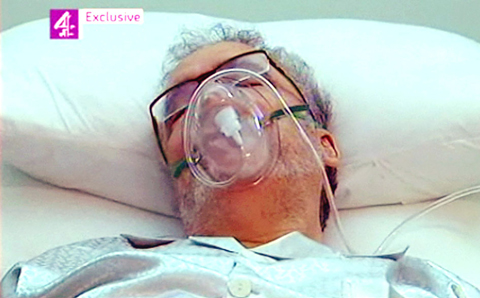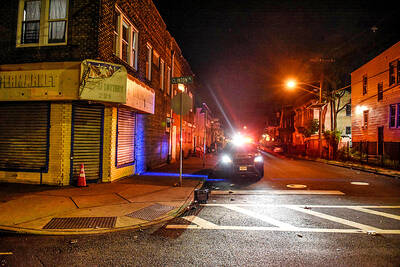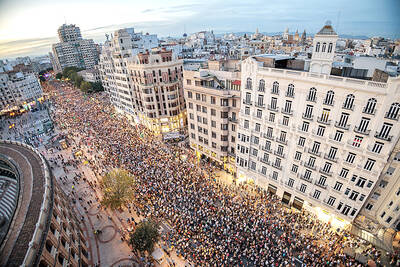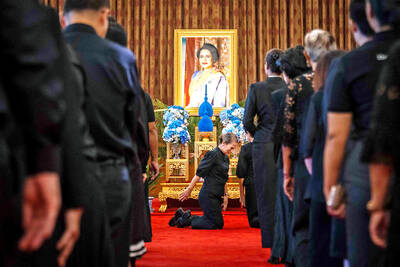British Prime Minister Gordon Brown was drawn into a damaging row yesterday over the release of the Lockerbie bomber after revelations a British minister told Libya the prime minister did not want him to die in prison.
Minister of State for the Armed Forces Bill Rammell confirmed late on Tuesday that he suggested to Libyan officials that the prime minister and Foreign Secretary David Miliband did not want bomber Abdelbaset Ali Mohmet al-Megrahi to die in a Scottish jail.
Rammell’s comments to the Libyans were contained in notes of a meeting released earlier on Tuesday by the Scottish government about Megrahi, the only person convicted of the 1988 bombing that killed 270.

PHOTO: AFP
“I did say that,” Rammell told the BBC. “But we need to put it in context. I was making it emphatically clear that this was a decision for Scottish ministers.”
Rammell also said: “I have not discussed this [his comments] with the prime minister either before or after [his meeting].”
Rammell, then Minister of State for Foreign and Commonwealth Affairs, met a Libyan minister and officials in Tripoli in February, six months before the release, a move that sparked outrage from the White House and US relatives of the victims.
The revelations are likely to increase pressure on Brown, whose government has insisted that the decision to release Megrahi on compassionate grounds was one solely taken by the semi-autonomous Scottish government.
The leader of the opposition Conservatives accused Brown of “double dealing” on the issue and called for an independent inquiry into what the government had “done in our name.”
“Tonight the British government stands accused and indeed the prime minister stands accused of double dealing,” leader David Cameron said. “On the one hand apparently saying to the Americans they wanted Megrahi to die in prison, but on the other hand saying privately to the Libyans that they wanted him released.”
The Brown government also published letters and documents on the Megrahi case on Tuesday in a bid to defuse the increasingly damaging row.
The government hoped publication of the documents would counter accusations that Megrahi was released as part of a deal to smooth the wheels of a massive oil and gas deal with oil-rich Libya.
Notes from a meeting between Libya’s minister for Europe, Abdulati Alobidi, and Scottish officials on March 12 suggested Brown and Miliband were opposed to Megrahi dying in a Scottish jail.
The notes, published by the Scottish government, said: “Mr Alobidi confirmed that he had reiterated to Mr Rammell that the death of Mr Megrahi in a Scottish prison would have catastrophic effects for the relationship between Libya and the UK. Mr Alobidi went on to say that Mr Rammell had stated that neither the Prime Minister nor the Foreign Secretary would want Mr Megrahi to pass away in prison but the decision on transfer lies in the hands of the Scottish ministers.”
Scotland freed Megrahi on Aug. 20 because he has terminal cancer. The Libyan served eight years of a life sentence for the bombing of a Pan Am jet over the Scottish town of Lockerbie in 1988.
Britain and the US condemned the joyous scenes that greeted his return to Tripoli, despite an appeal from Brown in a letter to Libyan leader Muammar Qaddafi to keep the occasion low-key.
The release of the letters came as Qaddafi marked the 40th anniversary on Tuesday of the bloodless coup that brought him to power.
Susan Cohen, whose daughter was killed in the Lockerbie atrocity, accused politicians on all sides of putting profits before justice.
“I think there was collusion between the governments. It’s all very horrible — it was all down to financial contracts,” she said.

DOUBLE-MURDER CASE: The officer told the dispatcher he would check the locations of the callers, but instead headed to a pizzeria, remaining there for about an hour A New Jersey officer has been charged with misconduct after prosecutors said he did not quickly respond to and properly investigate reports of a shooting that turned out to be a double murder, instead allegedly stopping at an ATM and pizzeria. Franklin Township Police Sergeant Kevin Bollaro was the on-duty officer on the evening of Aug. 1, when police received 911 calls reporting gunshots and screaming in Pittstown, about 96km from Manhattan in central New Jersey, Hunterdon County Prosecutor Renee Robeson’s office said. However, rather than responding immediately, prosecutors said GPS data and surveillance video showed Bollaro drove about 3km

Tens of thousands of people on Saturday took to the streets of Spain’s eastern city of Valencia to mark the first anniversary of floods that killed 229 people and to denounce the handling of the disaster. Demonstrators, many carrying photos of the victims, called on regional government head Carlos Mazon to resign over what they said was the slow response to one of Europe’s deadliest natural disasters in decades. “People are still really angry,” said Rosa Cerros, a 42-year-old government worker who took part with her husband and two young daughters. “Why weren’t people evacuated? Its incomprehensible,” she said. Mazon’s

‘MOTHER’ OF THAILAND: In her glamorous heyday in the 1960s, former Thai queen Sirikit mingled with US presidents and superstars such as Elvis Presley The year-long funeral ceremony of former Thai queen Sirikit started yesterday, with grieving royalists set to salute the procession bringing her body to lie in state at Bangkok’s Grand Palace. Members of the royal family are venerated in Thailand, treated by many as semi-divine figures, and lavished with glowing media coverage and gold-adorned portraits hanging in public spaces and private homes nationwide. Sirikit, the mother of Thai King Vajiralongkorn and widow of the nation’s longest-reigning monarch, died late on Friday at the age of 93. Black-and-white tributes to the royal matriarch are being beamed onto towering digital advertizing billboards, on

SECRETIVE SECT: Tetsuya Yamagami was said to have held a grudge against the Unification Church for bankrupting his family after his mother donated about ¥100m The gunman accused of killing former Japanese prime minister Shinzo Abe yesterday pleaded guilty, three years after the assassination in broad daylight shocked the world. The slaying forced a reckoning in a nation with little experience of gun violence, and ignited scrutiny of alleged ties between prominent conservative lawmakers and a secretive sect, the Unification Church. “Everything is true,” Tetsuya Yamagami said at a court in the western city of Nara, admitting to murdering the nation’s longest-serving leader in July 2022. The 45-year-old was led into the room by four security officials. When the judge asked him to state his name, Yamagami, who